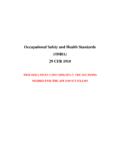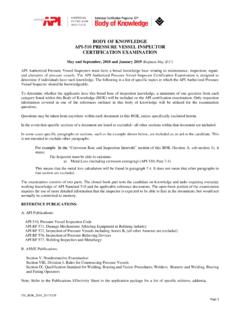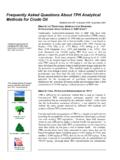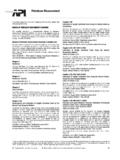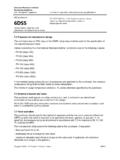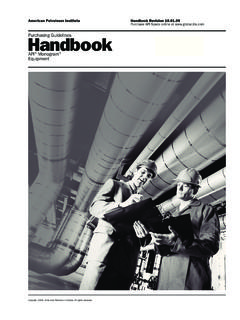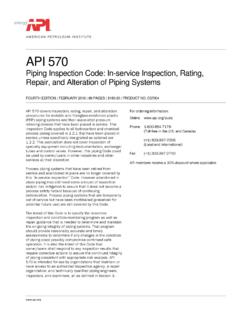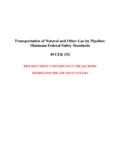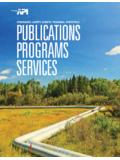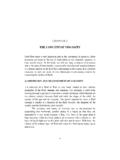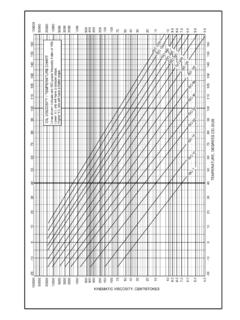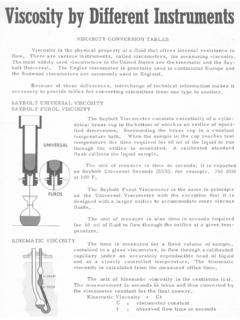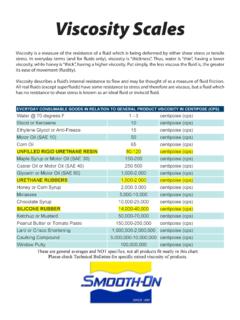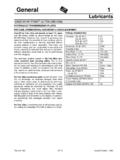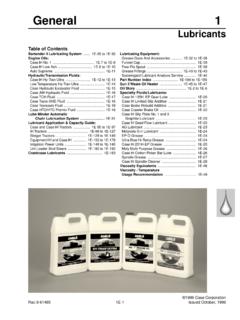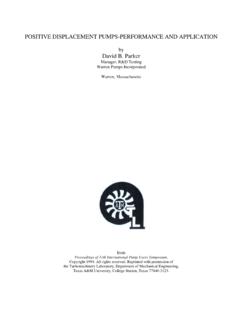Transcription of APPENDIX F—API Guidelines for SAE Viscosity–grade …
1 ANNEX F API Guidelines FOR SAE viscosity grade engine TESTING. General If an oil is eligible for SAE viscosity - grade engine Test Guidelines for passenger car motor oils or diesel engine oils and the sponsoring company desires to waive testing, the sponsoring company shall conform to the registration process, the ACC Code, and the Multiple Test Evaluation Procedure for the required engine tests. SAE viscosity CRITERIA. The SAE viscosity grades constitute a classification for engine lubricating oils in rheological terms only and are intended for use by engine manufacturers in determining the engine oil viscosity grades to be recommended for use in their engines and by oil marketers in formulating and labeling their products. Two series of viscosity grades are defined in SAE J300: (a) those that contain the letter W and those that do not contain the letter W.
2 Single- viscosity - grade oils ( single-grades ) with the letter W are defined by maximum low-temperature cranking and pumping viscosities and a minimum kinematic viscosity at 100 C. Single grades without the letter W are based on a set of minimum and maximum kinematic viscosities at 100 C and a minimum high-temperature/high-shear measured at 150 C and 1 million reciprocal seconds. Multiple- viscosity - grade oils ( multigrades ) are defined by all of the following criteria: a. Maximum low-temperature cranking and pumping viscosities. b. A kinematic viscosity at 100 C that falls within the prescribed range of one of the non-W grade classifications. c. A minimum high-temperature/high-shear viscosity at 150 C and 1 million reciprocal seconds. viscosity - grade READ ACROSS Guidelines . In certain situations, data generated from one viscosity grade of a given engine oil formulation may be extrapolated to another viscosity grade that uses the same additive technology by means of a practice commonly referred to as read-across (See Tables F-1 through F-13).
3 These viscosity - grade engine Testing Guidelines can be used to complete a testing program using the most severe viscosity grade for each individual test for the grades being licensed. engine tests shall be registered using the ACC Code. No read-across or substitute data are permitted for physical and chemical analyses or for bench tests (except as allowed in and ); that is, all specified physical and chemical analyses must be run on the final formulation. Proposed changes to the read-across tables or should be sent to the Chair of API's Base Oil Interchange (BOI)/ viscosity grade Read-Across (VGRA) Task Force or API. The proposal must include a justification and supporting data for such change. PRINCIPLES FOR viscosity GRADES NOT COVERED. Tables F-2 through F-12 indicate when a viscosity grade read-across is allowed (X) and not allowed ( ).
4 For viscosity grades not included in those tables, read-across is allowed for certain tests if the viscosity grades meet all the applicable technical principles described in Table F-1. Read-across for viscosity grades not covered by Tables F-1 through F-13 is not allowed until API's BOI/VGRA Task Force reviews the justification and data supporting a change to the tables and recommends the change to the API Lubricants Group and the Lubricants Group approves the change. Check marks in Table F-1 indicate which technical principles apply to a specific test. Paragraph provides examples on applying these technical principles to new viscosity grades. F-1 December 2016 Version (Reissued 01-04-2017). Table F-1 Technical Principles for New viscosity Grades and Read Across 150. (Applies to oils with HTHS mPa s). IID L-38/VIII IIIE/IIIF/ IIIGA IIIGB IVA VE VG VIA/VIB/VID.
5 Passenger Car Motor Oils IIIG (Note 2). a Detergent (dispersant)- Note 3. inhibitor (DI) content of the read-across viscosity grade shall be equal to or higher than that of the original viscosity grade . The increase in DI is limited to the maximum allowed by the ACC Code b Base stock blend kinematic NA NA NA NA Note 3. viscosity at 100 C of the read-across viscosity grade must be equal to or higher than that of the original viscosity grade , considering the precision of the test method c The viscosity modifier (VM) NA NA Note 4 Note 4 NA or or Note 3. content of the read-across Note Note viscosity grade must be equal 5 5. to or lower than that of the original viscosity grade Diesel engine Oils 1M-PC. a Detergent (dispersant)- . inhibitor (DI) content of the read-across viscosity grade shall be equal to or higher than that of the original viscosity grade .
6 The increase in DI is limited to the maximum allowed by the ACC Code b Base stock blend kinematic . viscosity at 100 C of the read-across viscosity grade must be equal to or higher than that of the original viscosity grade , considering the precision of the test method c The viscosity modifier (VM) . content of the read-across viscosity grade must be equal to or lower than that of the original viscosity grade d Finished oil volatility of the . read-across viscosity grade must be equal to or lower than that of the original viscosity grade Notes: 1. = principle is applicable; NA = not applicable. 2. Technical principles for the Sequence IIIGA are limited to 0W, 5W, and 10W multigrades. 3. New viscosity grades and associated read-across can only be added after review by the API BOI/VGRA Task Force and approval by the API Lubricants Group.
7 4. viscosity modifier content must be no more than times higher than the viscosity modifier content in the oil on which the test was run. 5. For dispersant-type VM, the VM content of the read-across viscosity grade must be equal to or higher than the original viscosity grade . 6. Read-across viscosity grades must contain an equal amount of the same Group V base stock ( , ester) in the finished oil blend if a Group V base stock is used in the original viscosity grade . F-2 December 2016 Version (Reissued 01-04-2017). Requirements for Passenger Car Motor Oils Blends shall use only base stocks as defined in Annex E. Base oils introduced from other manufacturers shall be tested in accordance with Annex E. The same detergent-(dispersant) inhibitor (DI) portion of the total performance additive package shall be used at equal or higher concentrations for alternative viscosity grades.
8 The increase in DI is limited to that allowed in the ACC Code. viscosity modifier, foam inhibitor, and pour point depressant levels may be adjusted for alternative viscosity grades, in accordance with the ACC Code. ACC Code and ASTM Multiple Test Evaluation Procedure testing practices shall be followed. Examples Using VGRA Tables and Technical Principles for VGRA. GENERAL. Read-across to or from viscosity grades not shown in the tables is allowed if the requirements in are met. If the requirements are not met, read-across is not allowed. Examples of how can be applied are provided below. EXAMPLE 1. In this example, a Sequence IIIE test is run on an SAE 0W-30 core viscosity grade [ , tested viscosity grade ]. What other viscosity grades can be covered by read-across from the tested SAE 0W-30? To answer this question, take the following steps: Step 1: Determine if requirement a in Table F-1 is met for all the desired read-across viscosity grades.
9 This requires keeping the DI constant, or if higher, consistent with the ACC Code of Practice. Since an SAE 0W-30 is most likely blended with some or all Group III or Group IV base stocks, many of the higher viscosity grades would probably not be part of this product line. The higher viscosity grades, if marketed, could have a different DI and/or base stock slate. Step 2: For the read-across viscosity grades ( , those you are reading to) of interest in Table F-4, determine if the requirements for both b and c in Table F-1 can be met concurrently. This involves having equal or higher base stock blend viscosity and a VM content in the read to multigrades that is no more than times higher than that in the SAE 0W-30. There are some grades that are certain to meet b and c , and some where it will depend on the blending approach. Some trial blends may have to be made.
10 Decide if there are single grades desired or feasible considering the base stocks used in the core formulation. Step 3: For viscosity grades that you wish to cover by read-across but are not shown in Table F-4, follow the instructions for b and c described in Step 2. Step 4: Determine which viscosity grades meet Table F-1 requirements a, b , and c . These grades are covered by viscosity grade read-across. Grades that fail to meet all these requirements are not covered by read- across. Note: The marketer of a formulation has the final responsibility for assuring that the product meets API requirements. EXAMPLE 2. In this example, an SAE 5W-30 blended with Group IV base stocks and a nondispersant VM has passed a VE. test. A marketer wants to read-across this test to an SAE 5W-40 grade , one not included in Table F-7. Since the SAE 5W-40 is not included in Table F-7, a, b , and c in Table F-1 must be consulted.
